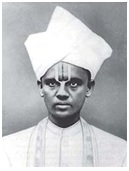V
vignesh2014
Guest
Shri Gurubyoh Namaha.Few of us have heard of Alasinga Perumal (Iyengar). Born in 1863, he was just a modest, deeply religious, high school teacher, who lived in Triplicane, Chennai (then called Madras). There was little exceptional about him, except – a big except – his devotion to Swami Vivekananda and how he helped shape a crucial part of Swamiji’s life. Alasinga Perumal was to Swamiji what Sri Hanuman was to Sri Rama. Not surprisingly, Swamiji regarded him ‘my dearest disciple’!

Alasinga PerumalIt all happened in 1892/1893. Alasinga had heard about a great Parliament of World Religions to be held in Chicago in 1893. He could have perhaps gone to the Parliament himself, but, given his modesty, he wanted someone else really scholarly to go. He tried to persuade some leading Hindus from Madras to do so but had failed.Around the same time, another young man, also just 30 years of age, had arrived in Madras. Born in 1863 as Narendranath (later to be called Swami Vivekananda), he had met Ramakrishna Paramahamsa in 1881 and had become a most ardent disciple by the time of his guru’s Samadhi in 1885. During 1888 -93, he wandered all over India, spreading the mission and message of Ramakrishna and towards the end of his Bharat darshan came to Madras and spent several months and met Alasinga.In Madras, Alasinga initially just organised Vivekananda’s lectures. But, once he got to know Vivekananda, he was in no doubt as to who would be the best Hindu to go to Chicago. He therefore not only suggested that Vivekananda goes to the Parliament (indeed, as suggested by several other prominent people such as Raja of Ramnad), but offered to collect the required funds and make it feasible. He set about building a modern version of Rama Sethu so that his ‘Rama’ could go across the seas and conquer. He succeeded in collecting the money required only at second attempt: at Swami Vivekananda’s instance the contributors were mostly poor people but included the Mysore Maharaja, Hyderabad Nizam and others. His devotion was so great that he literally carried Swami Vivekananda’s luggage on to the boat, ‘Peninsular’, in Bombay bound for the America and saw him off.Vivekananda arrived in USA some six weeks ahead of the opening of the Parliament but his visit did not start auspiciously. He had lost the travelers cheques he had brought and what little cash he was left with was getting depleted fast. Autumn had set in Chicago and he was not equipped for the cold weather. One night, he sought to sleep in the Railway platform as one could have done in India, but could not and therefore spent the night in an empty packing case. Most importantly, he learnt that he could not attend the Parliament as he had not registered in time. Three weeks before the opening date, he wrote in some desperation to, whom else but, Alasinga.‘Expenses are awful. You gave me 179 pounds in India. Now it is down to 130. America is expensive and it costs me one pound a day, despite the fact I am now living as a guest of an old lady in a village near Boston, who shows me off to her friends as a curio from India. All those rosy ideas we had before I started have melted. Starvation, cold, hooting in the streets because of my dress, these are all the things I have to fight against. But, no great things were ever done without great labour. I have a call from ABOVE and I must stick to my guns’‘Before you get this letter I will be down to 60 or 70 pounds. Try your best to send some money – if not for keeping me for a while, at least to help me get me out of this country. In the meantime, if anything turns out in my favour, I will wire – mindful though that a word costs about a pound!’Alasinga promptly collected some money and sent it to him. In the meantime, one Professor John Henry Wright of Harvard University had heard about Swamiji and in his second attempt managed to meet him. The professor was enthralled with the meeting and assumed he was going to the Parliament. When told that the deadline for registration had already passed and in any case he had no sponsors, Professor Wright told him ‘To ask for your credentials is like asking the sun to state its right to shine.’ He promptly wrote to the Chairman of the Parliament ‘Here is a man more learned than all our professors put together’ and also organized the funds for the trip and other logistics. It is pointless wondering whether but for the chance meeting with the professor Swamiji would have attended the Parliament: he was a man of destiny and one way or other he would have attended the Parliament!On September 11, 1893, the Parliament opened. On the first day itself, after four other prepared speeches were read, Swamiji was asked to speak. In one of the greatest orations, he started with ‘Sisters and Brothers of America’ – five immortal words that made the 7000 strong audience to stand up in the realization they were witnessing an epochal moment. The speech was very brief, but, so brilliant was he that overnight he became a sensation. Life-size portraits of Swamiji, who only a few weeks earlier been told he could not attend the conference, quickly adorned the streets of Chicago!In the Parliament itself, he became the star attraction and spoke five more times. He showcased all the great qualities that characterized his later work and his life’s mission –

Alasinga Perumal
- His immense pride in Hinduism
- An ability to make profound and clear expositions on Hinduism
- Tolerance and indeed respect for other religions
- Acting as a bridge between the East and West
- Skills as an orator especially in English.
